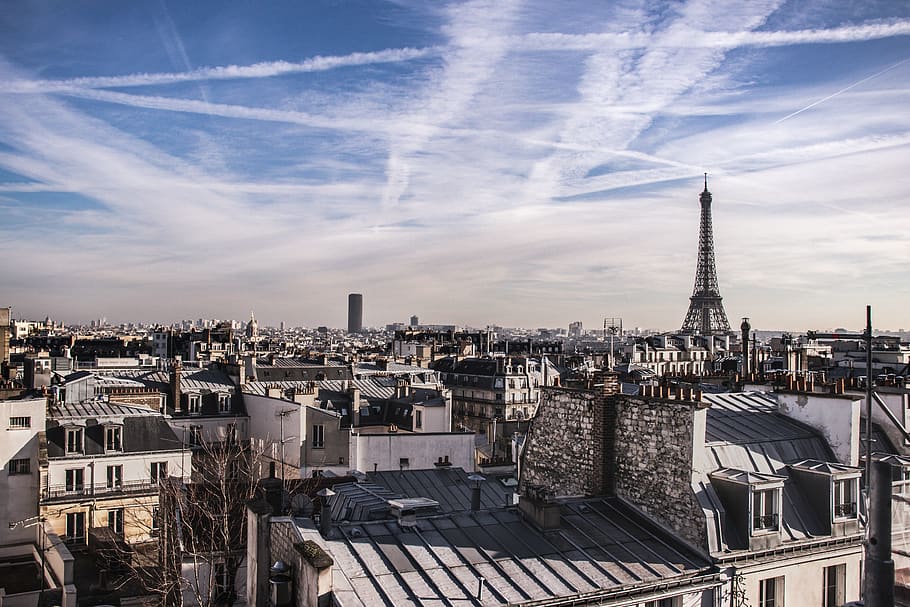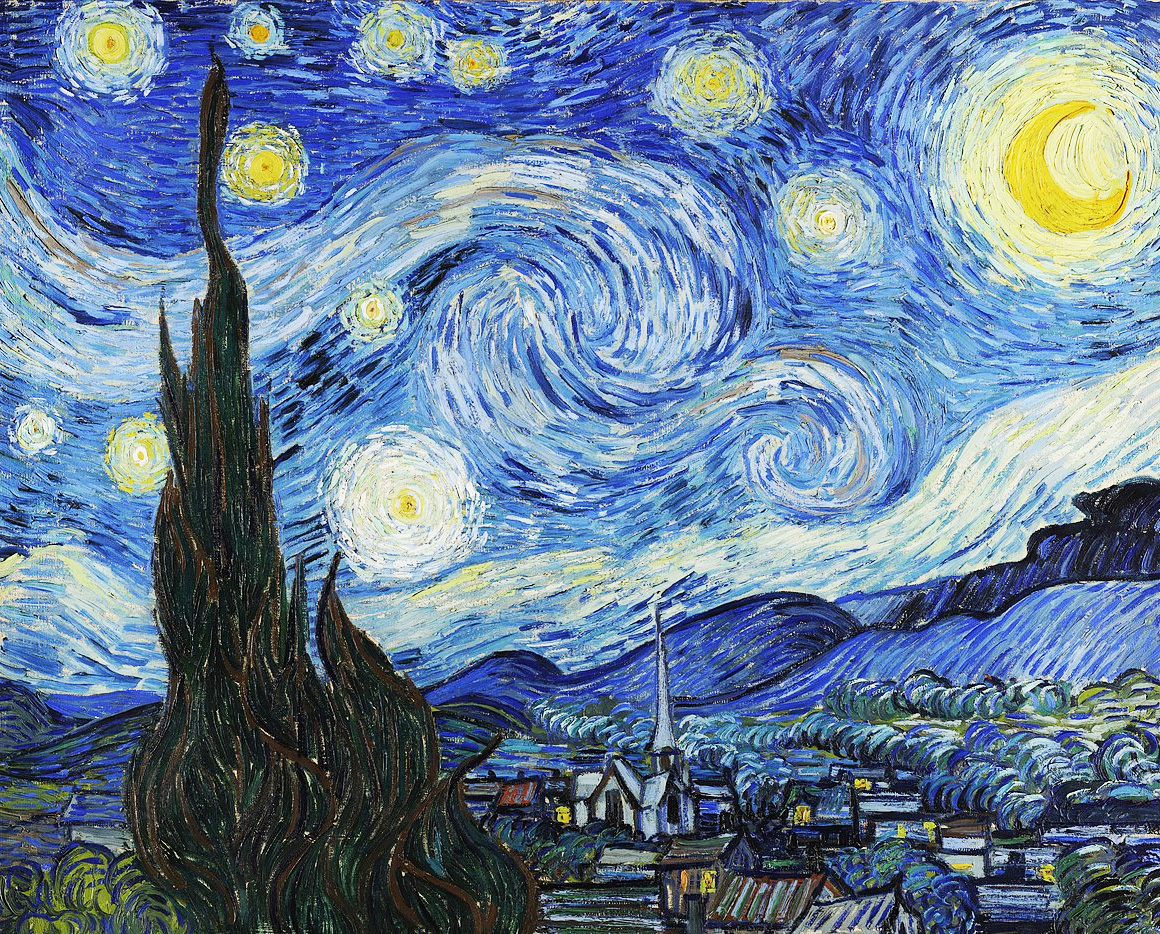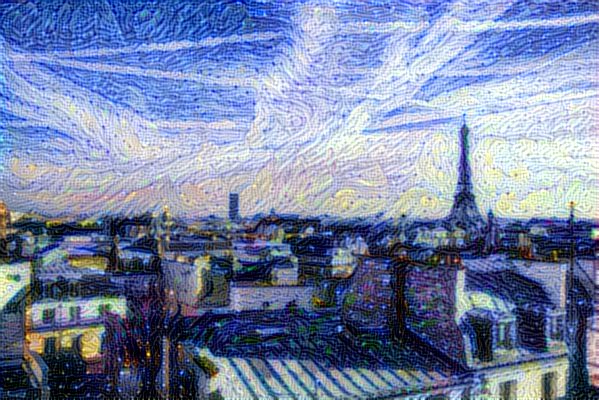신경 스타일 전송
- 원본 링크 : https://keras.io/examples/generative/neural_style_transfer/
- 최종 확인 : 2024-11-23
저자 : fchollet
생성일 : 2016/01/11
최종 편집일 : 2020/05/02
설명 : 그래디언트 하강법을 사용하여, 참조 이미지의 스타일을 타겟 이미지로 전송하기
소개
스타일 전송은 베이스 이미지와 동일한 “콘텐츠"를 가진 이미지를 생성하되, “스타일"은 다른 이미지(일반적으로 예술적 이미지)의 스타일을 따르는 방식입니다. 이는 3가지 구성 요소를 가진 손실 함수의 최적화를 통해 이루어집니다: “스타일 손실”, “콘텐츠 손실”, 그리고 “총 변동 손실(total variation loss)”
- 총 변동 손실은
- 조합 이미지의 픽셀 간 지역적 공간 연속성을 부여하여, 시각적 일관성을 제공합니다.
- 스타일 손실은
- 딥러닝이 관여하는 부분으로, 이는 심층 컨볼루션 신경망을 사용하여 정의됩니다.
- 정확히 말하면, 스타일 손실은 ImageNet에 대해 트레이닝된 convnet의 서로 다른 레이어에서 추출된,
- 베이스 이미지와 스타일 참조 이미지의 표현들에 대한 Gram matrices 간의 L2 거리의 합으로 구성됩니다.
- 일반적인 아이디어는 서로 다른 공간적 규모에서 색상 및 텍스처 정보를 캡처하는 것입니다.
- 이때 공간적 규모는 레이어의 깊이에 따라 정의되며, 상당히 큰 규모에서 처리됩니다.
- 딥러닝이 관여하는 부분으로, 이는 심층 컨볼루션 신경망을 사용하여 정의됩니다.
- 콘텐츠 손실은
- 기본 이미지(딥 레이어에서 추출된)의 특징과 조합 이미지의 특징 간의 L2 거리로 정의되며, 생성된 이미지가 원본과 충분히 유사하도록 유지합니다.
참조: A Neural Algorithm of Artistic Style
셋업
import os
os.environ["KERAS_BACKEND"] = "tensorflow"
import keras
import numpy as np
import tensorflow as tf
from keras.applications import vgg19
base_image_path = keras.utils.get_file("paris.jpg", "https://i.imgur.com/F28w3Ac.jpg")
style_reference_image_path = keras.utils.get_file(
"starry_night.jpg", "https://i.imgur.com/9ooB60I.jpg"
)
result_prefix = "paris_generated"
# 각 손실 요소들의 가중치
total_variation_weight = 1e-6
style_weight = 1e-6
content_weight = 2.5e-8
# 생성된 이미지의 크기.
width, height = keras.utils.load_img(base_image_path).size
img_nrows = 400
img_ncols = int(width * img_nrows / height)결과
Downloading data from https://i.imgur.com/F28w3Ac.jpg
102437/102437 ━━━━━━━━━━━━━━━━━━━━ 0s 0us/step
Downloading data from https://i.imgur.com/9ooB60I.jpg
935806/935806 ━━━━━━━━━━━━━━━━━━━━ 0s 0us/step베이스(콘텐츠) 이미지와 스타일 참조 이미지를 살펴봅시다
from IPython.display import Image, display
display(Image(base_image_path))
display(Image(style_reference_image_path))

이미지 전처리 / 후처리 유틸리티
def preprocess_image(image_path):
# 이미지를 열고, 크기를 조정하고, 적절한 텐서로 포맷(형식 변환)하는 유틸리티 함수
img = keras.utils.load_img(image_path, target_size=(img_nrows, img_ncols))
img = keras.utils.img_to_array(img)
img = np.expand_dims(img, axis=0)
img = vgg19.preprocess_input(img)
return tf.convert_to_tensor(img)
def deprocess_image(x):
# 텐서를 유효한 이미지로 변환하는 유틸리티 함수
x = x.reshape((img_nrows, img_ncols, 3))
# 평균 픽셀값으로부터 영점 중심(zero-center) 제거
x[:, :, 0] += 103.939
x[:, :, 1] += 116.779
x[:, :, 2] += 123.68
# 'BGR'->'RGB'
x = x[:, :, ::-1]
x = np.clip(x, 0, 255).astype("uint8")
return x스타일 변환 손실 계산
먼저, 4개의 유틸리티 함수들을 정의해야 합니다:
gram_matrix- 스타일 손실을 계산하는 데 사용
style_loss함수- 스타일 참조 이미지의 로컬 텍스처에 생성된 이미지가 가깝도록 유지
content_loss함수- 생성된 이미지의 높은 레벨 표현이 베이스 이미지와 가깝도록 유지
total_variation_loss함수- 생성된 이미지를 로컬에서 일관성(locally-coherent) 있게 유지하는 정규화 손실
# 이미지 텐서의 gram matrix (특성 간 외적(outer product))
def gram_matrix(x):
x = tf.transpose(x, (2, 0, 1))
features = tf.reshape(x, (tf.shape(x)[0], -1))
gram = tf.matmul(features, tf.transpose(features))
return gram
# "style loss"는 참조 이미지의 스타일을 생성된 이미지에서 유지하기 위해 설계되었습니다.
# 이는 스타일 참조 이미지와 생성된 이미지의
# 특성 맵에서 gram matrices(스타일을 포착하는)을 기반으로 합니다.
def style_loss(style, combination):
S = gram_matrix(style)
C = gram_matrix(combination)
channels = 3
size = img_nrows * img_ncols
return tf.reduce_sum(tf.square(S - C)) / (4.0 * (channels**2) * (size**2))
# 생성된 이미지에 베이스 이미지의 "콘텐츠"를 유지하도록 설계된 보조 손실 함수
def content_loss(base, combination):
return tf.reduce_sum(tf.square(combination - base))
# 세 번째 손실 함수, 총 변동 손실(total variation loss),
# 생성된 이미지가 로컬에서 일관성을 유지하도록 설계되었습니다.
def total_variation_loss(x):
a = tf.square(
x[:, : img_nrows - 1, : img_ncols - 1, :] - x[:, 1:, : img_ncols - 1, :]
)
b = tf.square(
x[:, : img_nrows - 1, : img_ncols - 1, :] - x[:, : img_nrows - 1, 1:, :]
)
return tf.reduce_sum(tf.pow(a + b, 1.25))다음으로, VGG19의 중간 활성값을 사전(dict) 형식으로 가져오는 특성 추출 모델을 생성해보겠습니다.
# 사전 트레이닝된 ImageNet 가중치로 로드된 VGG19 모델을 빌드합니다.
model = vgg19.VGG19(weights="imagenet", include_top=False)
# 각 "key" 레이어의 상징적인 출력값을 가져옵니다. (고유한 이름을 부여했습니다)
outputs_dict = dict([(layer.name, layer.output) for layer in model.layers])
# VGG19의 모든 레이어에 대해 활성화 값을 반환하는 모델을 설정합니다. (dict로)
feature_extractor = keras.Model(inputs=model.inputs, outputs=outputs_dict)결과
Downloading data from https://storage.googleapis.com/tensorflow/keras-applications/vgg19/vgg19_weights_tf_dim_ordering_tf_kernels_notop.h5
80134624/80134624 ━━━━━━━━━━━━━━━━━━━━ 2s 0us/step마지막으로, 스타일 전이 손실을 계산하는 코드입니다.
# 스타일 손실에 사용할 레이어 목록
style_layer_names = [
"block1_conv1",
"block2_conv1",
"block3_conv1",
"block4_conv1",
"block5_conv1",
]
# 콘텐츠 손실에 사용할 레이어
content_layer_name = "block5_conv2"
def compute_loss(combination_image, base_image, style_reference_image):
input_tensor = tf.concat(
[base_image, style_reference_image, combination_image], axis=0
)
features = feature_extractor(input_tensor)
# 손실 초기화
loss = tf.zeros(shape=())
# 콘텐츠 손실 추가
layer_features = features[content_layer_name]
base_image_features = layer_features[0, :, :, :]
combination_features = layer_features[2, :, :, :]
loss = loss + content_weight * content_loss(
base_image_features, combination_features
)
# 스타일 손실 추가
for layer_name in style_layer_names:
layer_features = features[layer_name]
style_reference_features = layer_features[1, :, :, :]
combination_features = layer_features[2, :, :, :]
sl = style_loss(style_reference_features, combination_features)
loss += (style_weight / len(style_layer_names)) * sl
# 전체 변화 손실 추가
loss += total_variation_weight * total_variation_loss(combination_image)
return losstf.function 데코레이터 추가하여 손실 및 그라디언트 계산
컴파일하여, 빠르게 만들기 위해, tf.function 데코레이터를 추가합니다.
@tf.function
def compute_loss_and_grads(combination_image, base_image, style_reference_image):
with tf.GradientTape() as tape:
loss = compute_loss(combination_image, base_image, style_reference_image)
grads = tape.gradient(loss, combination_image)
return loss, grads트레이닝 루프
손실을 최소화하기 위해 기본적인 그라디언트 하강법 스텝을 반복하여 실행하며, 100번 반복할 때마다 결과 이미지를 저장합니다.
학습률은 100 스텝마다 0.96으로 감소시킵니다.
optimizer = keras.optimizers.SGD(
keras.optimizers.schedules.ExponentialDecay(
initial_learning_rate=100.0, decay_steps=100, decay_rate=0.96
)
)
base_image = preprocess_image(base_image_path)
style_reference_image = preprocess_image(style_reference_image_path)
combination_image = tf.Variable(preprocess_image(base_image_path))
iterations = 4000
for i in range(1, iterations + 1):
loss, grads = compute_loss_and_grads(
combination_image, base_image, style_reference_image
)
optimizer.apply_gradients([(grads, combination_image)])
if i % 100 == 0:
print("Iteration %d: loss=%.2f" % (i, loss))
img = deprocess_image(combination_image.numpy())
fname = result_prefix + "_at_iteration_%d.png" % i
keras.utils.save_img(fname, img)결과
Iteration 100: loss=11021.63
Iteration 200: loss=8516.82
Iteration 300: loss=7572.36
Iteration 400: loss=7062.23
Iteration 500: loss=6733.57
Iteration 600: loss=6498.27
Iteration 700: loss=6319.11
Iteration 800: loss=6176.94
Iteration 900: loss=6060.49
Iteration 1000: loss=5963.24
Iteration 1100: loss=5880.51
Iteration 1200: loss=5809.23
Iteration 1300: loss=5747.35
Iteration 1400: loss=5692.95
Iteration 1500: loss=5644.84
Iteration 1600: loss=5601.82
Iteration 1700: loss=5563.18
Iteration 1800: loss=5528.38
Iteration 1900: loss=5496.89
Iteration 2000: loss=5468.20
Iteration 2100: loss=5441.97
Iteration 2200: loss=5418.02
Iteration 2300: loss=5396.11
Iteration 2400: loss=5376.00
Iteration 2500: loss=5357.49
Iteration 2600: loss=5340.36
Iteration 2700: loss=5324.49
Iteration 2800: loss=5309.77
Iteration 2900: loss=5296.08
Iteration 3000: loss=5283.33
Iteration 3100: loss=5271.47
Iteration 3200: loss=5260.39
Iteration 3300: loss=5250.02
Iteration 3400: loss=5240.29
Iteration 3500: loss=5231.18
Iteration 3600: loss=5222.65
Iteration 3700: loss=5214.61
Iteration 3800: loss=5207.08
Iteration 3900: loss=5199.98
Iteration 4000: loss=5193.274000번의 반복 후, 다음과 같은 결과를 얻게 됩니다:
display(Image(result_prefix + "_at_iteration_4000.png"))